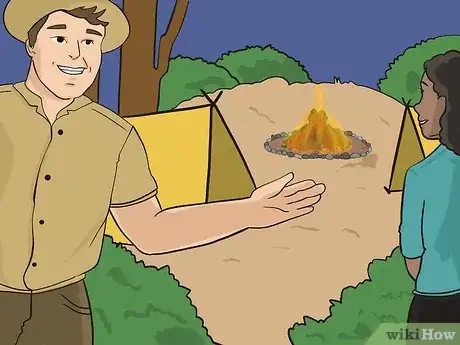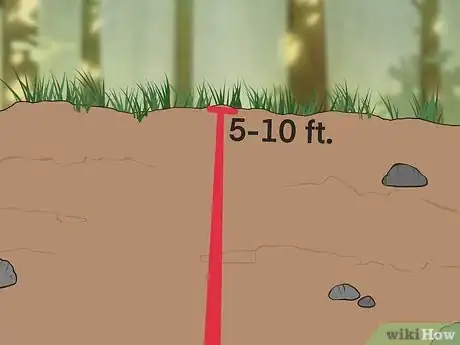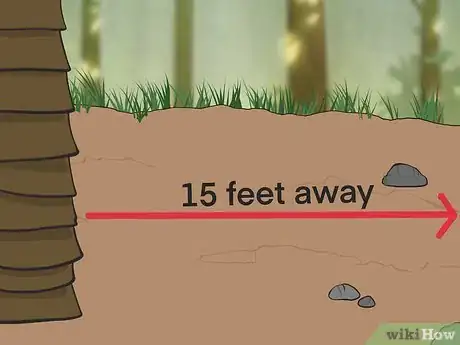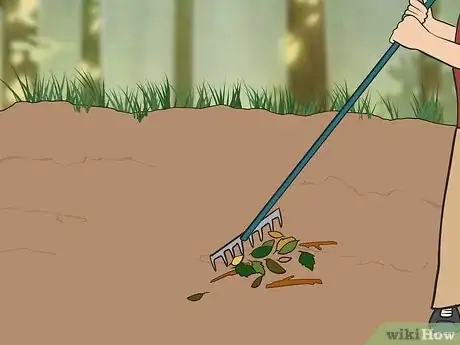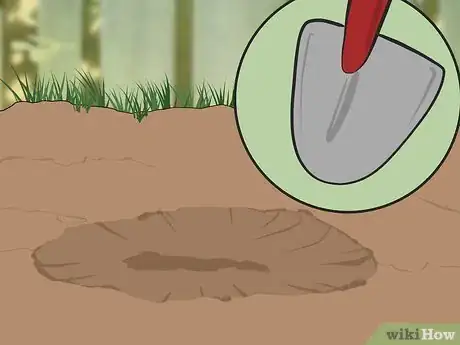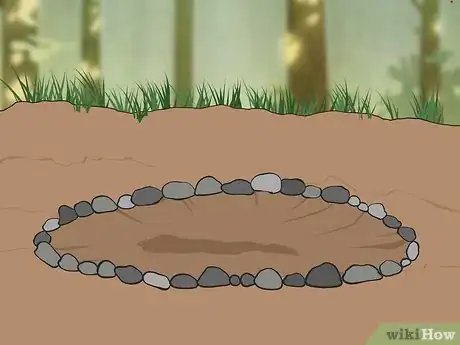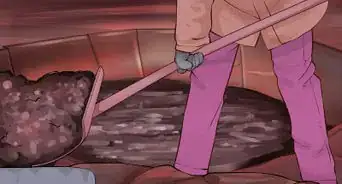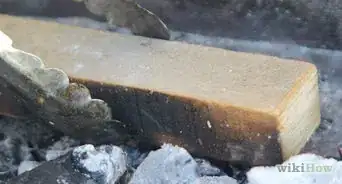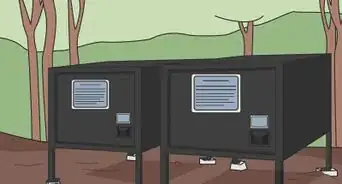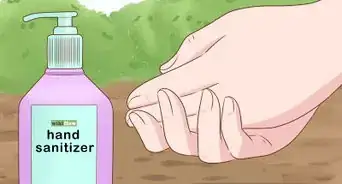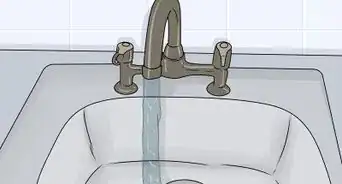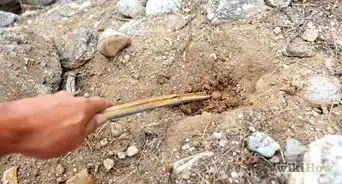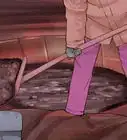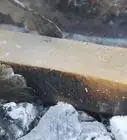This article was co-authored by Britt Edelen. Britt Edelen was an active member of his local Boy Scouts troop near Athens, Georgia from ages 8 to 16. As a Scout, he went on dozens of camping trips, learned and practiced many wilderness survival skills, and spent countless hours appreciating the great outdoors. In addition, Britt worked as a counselor for several summers at an adventure camp in his hometown, which allowed him to share his passion for and knowledge of the outdoors with others.
This article has been viewed 49,238 times.
Enjoying a night under the stars in the great outdoors with a crackling campfire nearby is tough to beat. However, it's important to remember that a successful campfire is a safe campfire. Choosing the right spot for your fire, crafting a containment ring to keep the coals from escaping, and keeping supplies handy to quickly extinguish the flames are the keys to building a safe campfire.
Steps
Selecting the Area for the Pit
-
1Make sure it’s legal to start a fire in your area. Before you build a campfire pit, you need to make sure it’s allowed and if there any special steps or precautions that you’re required to take. If you’re at a campground or a park, ask the park ranger or check the rules about building a fire. There may be rules about where or how large of a fire you can build. If you’re not sure, don’t build a fire![1]
- Check the local fire-danger level, which is usually displayed at ranger stations or along roads. If you can’t find one, try looking online or calling the local government office.
- Respect established fire pits. Do not make a new fire pit unless it is necessary. Using established fire pits avoids damaging the soil and local flora.
Warning: Sometimes the weather conditions make building a fire dangerous. High winds or a drought could increase the risk of starting a wildfire, so make sure you know if it’s permitted to start a fire before you do it.
-
1Select a flat spot away from trees, dry grass, and lots of leaves. Low hanging branches from trees and lots of brush or dry grass can easily catch fire and get out of control quickly. Choosing flat and level ground to build a campfire pit will also help prevent any coals or embers from rolling away. A good rule of thumb is to choose an area that is at least 5–10 feet (1.5–3.0 m) away from trees and brush.[2]
-
2Pick a spot that protects your fire pit from the wind. Take note of strong prevailing winds and choose a location that is protected from direct exposure to them. Strong winds can blow coals from the fire and spread it. Try to avoid building a campfire pit in an open area exposed to high winds.[3]
- Use natural features like hills or boulders to shield your fire pit from the wind.
- Arrange your camp so that the wind is at your back to block or deflect it from blowing directly onto your fire.
- If the wind is strong enough to blow debris around, it’s too windy to start a fire!
-
3Choose a place at least 15 feet (4.6 m) away from your lodging. It may be tempting to build a nice fire near the entrance of your cabin or tent to help keep warm, but the materials that make up your tent, cabin, or other form of lodging may not need to be exposed to a direct flame to heat up and catch fire. Be sure to choose a place for your fire pit that’s far enough away from your lodging and camping supplies.[4]
- Don’t place a sleeping bag next to a campfire because the material could catch fire before you notice it!
Building a Containment Ring
-
1Clear an area at least 10 feet (3.0 m) around the pit. Before you start to build the containment ring for your fire, you should remove any fire hazards that could cause the fire to spread. Pick up any sticks, leaves, or other flammable material around the area of your fire pit.[5]
- Even if the leaves or branches are damp, you still need to clear them from the area because they could dry out and catch fire.
- Try to rake up any dry leaves as well.
-
2Dig out a bowl-shaped indentation about 5 inches (13 cm) deep. A small indentation in the ground will help contain the coals and protect them from the wind. It also allows your fire to burn bright and hot with less smoke because the coals are concentrated in the bowl. Use a shovel or a sturdy stick to dig out the indentation.[6]
- The width of the bowl could vary depending on how large of a fire you’re building, but a 1 foot (0.30 m) diameter bowl should be sufficient for most campfires.
-
3Use rocks or large logs to form a 2 feet (0.61 m) diameter ring. Rocks that are fist-sized or larger are great for making a containment ring. Place them side by side without any gaps in between them to form a containment circle. You could also use large logs to make a ring around the fire pit—just make sure they’re not so dry that they’ll catch fire easily.[7]
- A ring with a 2 feet (0.61 m) diameter should be large enough for a medium-sized fire, but you can make a larger ring if needed.
Warning: Don’t use rocks that have been submerged in water or they can explode when they’re heated. Logs that are soaked in water are safe to use.
-
4Build a fire inside the containment ring. Gather some small brush or leaves for tinder, some dry, medium-sized branches for kindling, and larger dry logs to use as fuel for your fire.[8] Make a teepee structure with your tinder and kindling and light the tinder at the center of the teepee. Add the larger logs when the fire gets going.[9]
- You’ll need about 4-5 logs to keep a campfire burning for 2 hours, so make sure you gather enough.
- Keep the logs you plan to use as fuel at least 10 feet (3.0 m) away from the fire pit so there’s no chance they could catch fire.
- Make sure you gather enough fuel to last for as long as you need a fire.
- Bring your own firewood if there isn’t any available around you or if you’re not permitted to collect it. Contact a park ranger or a local government office to make sure you can gather and burn wood around you.
-
5Keep a bucket that holds 2 gallons (7.6 L) of water nearby. It’s always a good idea to keep a bucket or large container of water near the area of the fire pit in case you need to put out any sparks or embers that pop out of the fire. A fire can get out of control quickly, so keep enough water to put the whole fire out at a moment’s notice.[10]
- Always put out your fire when you are ready to leave. Soak the pit with water before you leave, even if you let the fire die out on its own.[11]
- Keep a fire extinguisher on hand as well to prevent a possible forest fire.
- Having water nearby also makes the job of extinguishing the fire quick and easy.
- If you don't have water, you may also use dirt or sand to cover the embers.[12]
Community Q&A
-
QuestionWhat do I need for a campfire?
 Community AnswerKindling, firewood, and matches or a lighter.
Community AnswerKindling, firewood, and matches or a lighter. -
QuestionCan I do this on grass?
 Galasy4969Top AnswererYou should avoid building a fire on top of grass. Dry grass catches easily; if you put fire on top of green grass, it destroys the nutrients in the soil. Find a patch of dirt or sand instead.
Galasy4969Top AnswererYou should avoid building a fire on top of grass. Dry grass catches easily; if you put fire on top of green grass, it destroys the nutrients in the soil. Find a patch of dirt or sand instead.
Things You’ll Need
- A 2 US gal (7.6 L) bucket
- Fire extinguisher
- Shovel or sturdy stick
- Rocks or large logs to form a ring
- Kindling
- Brush or leaves for tinder
- Medium-sized branches for kindling
- Large logs for fuel
Warnings
- Never leave a campfire unattended. Make sure your fire is completely extinguished before you leave the area or go to sleep.⧼thumbs_response⧽
References
- ↑ https://www.outsideonline.com/2392462/how-to-build-a-fire
- ↑ https://myopencountry.com/hiking-camping-tips-guides/diy-survival-guides/how-to-build-a-campfire/
- ↑ https://myopencountry.com/hiking-camping-tips-guides/diy-survival-guides/how-to-build-a-campfire/
- ↑ https://myopencountry.com/hiking-camping-tips-guides/diy-survival-guides/how-to-build-a-campfire/
- ↑ https://myopencountry.com/hiking-camping-tips-guides/diy-survival-guides/how-to-build-a-campfire/
- ↑ https://www.wildernesscollege.com/building-a-fire-pit.html
- ↑ https://myopencountry.com/hiking-camping-tips-guides/diy-survival-guides/how-to-build-a-campfire/
- ↑ Britt Edelen. Outdoor Educator. Expert Interview. 7 February 2020.
- ↑ http://www.wildbackpacker.com/wilderness-survival/articles/how-to-build-a-fire/
- ↑ https://www.wildernesscollege.com/building-a-fire-pit.html
- ↑ Britt Edelen. Outdoor Educator. Expert Interview. 7 February 2020.
- ↑ Britt Edelen. Outdoor Educator. Expert Interview. 7 February 2020.
